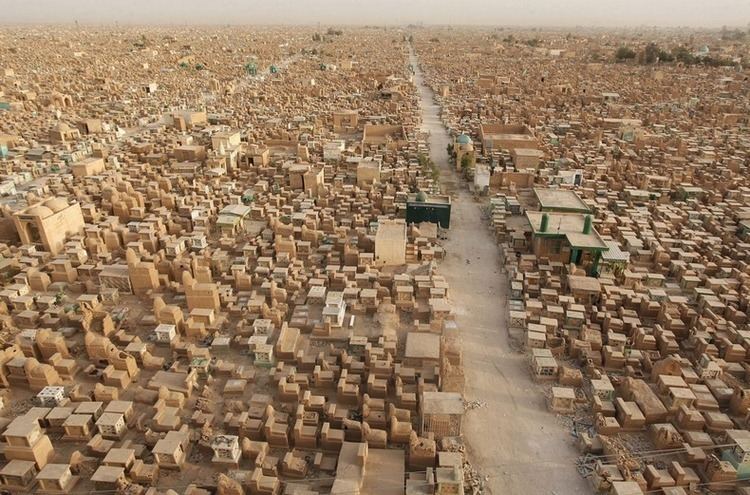 | ||
Similar Imam Ali Mosque, Al‑Sahlah Mosque, Al‑Hannanah mosque, Al‑Baqi', Great Mosque of Kufa | ||
Wadi Al-Salaam (Arabic وادي السلام; Valley of Peace) is an Islamic cemetery, located in the Shia holy city of Najaf, Iraq. It is the largest cemetery in the world. The cemetery covers 1,485.5 acres (601.16 ha; 6.01 km2; 2.32 sq mi) and contains over 5 million bodies. It also attracts millions of pilgrims annually.
Contents
The cemetery is located near the shrine of Imam Ali ibn Abi Talib, the fourth Sunni Caliph and the first Shia Imam. Thus, many Shiites in Iraq request that they be buried in this cemetery. As a result of improved transportation methods, Shi'ites from across the globe are (or seek to be) buried in the cemetery. However, burial at the cemetery "means being placed in one of the cemetery’s many catacombs." According to an undertaker at the cemetery, each crypt can hold up to 50 bodies. The burial plots are controlled by Marja'.
The Shia traditions
Shia tradition holds that Abraham bought land in Wadi-us-Salaam and that Ali said the Wadi Al-Salaam was a part of heaven. Shia also widely believe that Ali has the power to intercede for the deceased—lessening their suffering—during the passage of their soul from the worldly life and if they are buried there "they will be raised from the dead on judgment day with their spiritual leader."
The Shia are encouraged to bury their dead at the location through religious edicts and the cemetery's expansion is also seen as being a result of Shi'isms "more permissive attitude than Sunnism with regard to the commemoration of the dead and the erection of mausoleums."
Some rituals carried out before burial in the cemetery include: the body is washed and wrapped at the cemetery, the funeral prayers are conducted in the Imam Ali shrine, the deceased is carried around the shrine three times, and some Quranic verses are recited at the cemetery.
History
Daily burials have been on going for over 1,400 years and the site is on the Tentative List of UNESCO's World Heritage sites. Burials in Najaf have been documented as early as the Parthian and Sassanid eras and ancient Mesopotamian cities often had similar cemeteries, where there was an accumulation of tombs.
It is estimated that during the Iraq War about 200 to 250 corpses were buried there daily, however, in 2010 this number had decreased to less than 100. Approximately 500,000 new bodies are interred in the cemetery annually from across the globe. This figure is an increase on the approximately 20,000 bodies, primarily from Iran, that used to be interred annually in the early 20th century. Most Iraqi and many Iranian Shi'ites have a relative buried in the cemetery.
As of 2014—coinciding with conflict against ISIL—it has been reported that burial plots are running out, resulting in many being stolen, illegally resold or improvised. According to one gravedigger: “I’ve never had it so busy. Not even after 2003 or 2006 [the height of Iraq’s civil war].”
